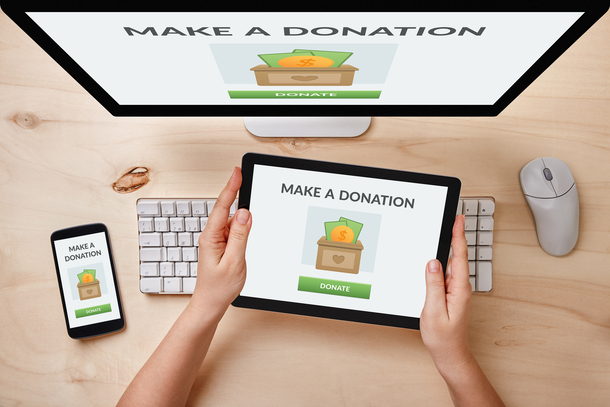
3 Tips for Creating a Nonprofit Homepage that Stands Out

Even if you’ve only recently started your nonprofit, you should put your best foot forward and start making connections right away. Building your network of donors, volunteers, and even nonprofit colleagues as soon as possible is important for guaranteeing you have a deep and long-lasting relationship.
The best tactic to start making your name in your community is by putting yourself out there for your prospects to see. That’s where your website and its homepage come in.
The flexibility of web design is a valuable opportunity for you to market yourself as a reputable, considerate, and eager player in the space. This is likely where you’ll convert the majority of casual visitors into committed supporters. Thus, you’ll want to make your homepage—the first impression your visitors get of your nonprofit—informative, visually appealing, and accessible.
We’ll be covering these essential tips for making an exceptional nonprofit homepage:
- Include your unique branding.
- Highlight your donation page.
- Optimize the user experience.
However, before we get into the web design process, it’s important to understand the basics so you start off on the right foot.
Let’s dive into how you’ll create an attractive and engaging homepage that draws your visitors in and makes them want to stay.
Understanding Web Design Fundamentals
Thankfully, you don’t need to reinvent the wheel to get your website up and running. Web developers recommend that to optimize your digital performance you should expend as little effort as possible for the highest-quality product. This way, you’ll maximize your return on your investment in developing your site.
This isn’t to say that you should simply slap your organization’s name on a sparse webpage and call it a day. On the contrary, your website content should be impactful, aesthetically pleasing, unique, and informative. However, you can achieve this outcome without overextending your time on building an overloaded site that doesn’t fit your needs. In fact, your approach should be straightforward and streamlined to give your visitors the information they need and inspire them to support you.
With this in mind, let’s explore the specific strategies you can use to achieve this homepage design.
- Include your unique branding.
No matter your goals or focus area, your nonprofit website is an essential part of your operations and outreach strategy, and you’ll want to set your website’s homepage apart from the rest. That’s where branding comes in.
At its core, your nonprofit’s branding is comprised of visual and mission-centered elements that are unique to your organization. While branding is usually associated with for-profit brands, your organization has just as much to gain from having a distinctive look and attitude. Putting your brand front and center on your homepage will immediately showcase part of your organization’s identity, engaging new visitors.
Here are some of the fundamental parts of your nonprofit’s brand that you should feature on your homepage:
- Colors. Colors evoke certain emotions from your audience, so carefully work with your team to pick a palette that matches your nonprofit’s attitude. Most nonprofits choose bright colors to represent their commitment to making the world a better place.
- Logo. Once you have your brand colors established, brainstorm a memorable logo that you can add to your homepage. Be sure to use eye-catching, yet professional images and fonts while creating your logo.
- Slogan. Along with your logo, this is an important part of what sets you apart from other nonprofits. You might want to borrow language from your mission statement so your slogan is relevant and impactful.
- Negative space. Hitting your visitors with a large block of text is likely to deter them from staying on your page. Use lots of negative space so your visitors can easily digest your content.
- Images. Images are powerful tools to convey your message because they transcend language and education levels. Spotlight your beneficiaries and your supporters in action on your homepage so visitors can immediately identify who you’re serving.
Your nonprofit’s brand allows you to shape your image however you please. So, let your imagination run wild, but always keep your mission at the forefront of the design process.
- Highlight your donation page.
Besides drawing your audience in, your website is a critical platform for your organization to collect donations. Using a centralized donation page is a user-friendly alternative to cumbersome and antiquated snail-mail giving forms. Your prospects likely prefer it as well. According to Double the Donation, 63% of donors prefer to donate online using a credit or debit card. Plus, it’s quite easy to add a donation page to your website with integrated processors such as PayPal that even connect to your CRM.
While your donation page won’t be the very first thing your visitors see on your website, ensure that it’s very clear how to access it from your homepage. To make your donation page as visible as possible, spotlight it on your homepage with bright clickable buttons and calls to action leading to your donation page. Furthermore, you can highlight specific donation impacts on your homepage. For instance, a food bank’s website might showcase the exact number of meals each donation provides.
- Optimize the user experience.
User experience (also known as UX) is how your website’s visitors interact with your pages. Essentially, your job is to make your user’s experience on your website seamless so they’re incentivized to come back. UX is especially important on your homepage because it’s the first impression your visitors get. Here are some of the characteristics you can implement to bolster your homepage’s UX:
- Make it accessible. The last thing you want to do is alienate an entire group of prospective supporters from your website. Ensure that you make your homepage accessible to people of all abilities. For instance, include alt text on images and use high-contrast colors so visually impaired people can perceive your content.
- Mobile-optimize it. More and more web users are using mobile devices as their primary means of browsing. This means you should accommodate this large audience by making your website mobile-friendly. Consider including features such as resized images and infinite scrolling so that mobile users can derive value from your homepage.
- Create intuitive navigation. Simply put, your homepage’s success is predicated on how well your visitors can use it. If your tabs are jumbled, your visitors will likely click off the page without giving. Be sure to organize your tabs in a logical way so that your visitors can get where they need to go.
To optimize your UX, start by putting yourself in your audience’s shoes. Think about what you like to see on a nonprofit homepage and brainstorm if it’s feasible to integrate them into your own. You might also reach out to your colleagues in the space and ask for suggestions about which features are the most important.
Ultimately, your homepage is the face of your organization’s online presence, and first impressions are crucial. It’s up to you to leverage it to get the most visitors invested in your cause as possible.
Now, it’s time to take the first step into creating your homepage by using a website builder designed specifically for nonprofits. As long as you center your beneficiaries, prioritize the user experience, and highlight ways to engage on your homepage, you’ll attract the right crowd who will help you achieve your mission.

